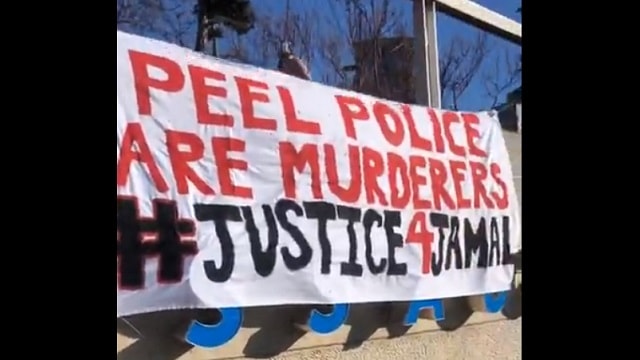CAUGHT ON VIDEO: Anti-police brutality group hangs highway banner calling for justice in Mississauga
Published January 24, 2021 at 2:04 am

Those driving on the highway in Mississauga may get a view of a highway banner calling for justice for Jamal Francique, a 28 year old who was fatally shot by police in January 2020.
The banner, which reads “Peel Police are Murderers #Justice4Jamal”, was shared in an Instagram video posted by the Malton People’s Movement (MPM), an anti-police brutality advocacy group.
MPM criticized Peel police for the actions that led to Francique’s death last January, and additionally criticized Ontario’s Special Investigations Unit (SIU), which recently declined to press criminal charges against the officer involved.
“It’s been one year since Jamal Francique was taken from his family in the most barbaric and unforgivable way,” the MPM said in a recent statement.
“Those who claim to protect us and uphold the law violated the most sacred of his rights — the right to life.”
The incident happened on the evening of Tuesday, January 7, 2020 when officers attended the area of Southampton Drive and Aquinas Avenue in Mississauga to make an arrest.
According to the SIU, police located Francique in a vehicle at which an officer fired multiple shots. Francique later succumbed to his injuries and was pronounced dead.
On Jan. 20, 2021, SIU director Joseph Martino said that “there are no reasonable grounds to believe that the officer who fired at Francique committed a criminal offence in connection with the fatal incident,” adding that he was “unable to reasonably conclude that the [officer’s] resort to lethal force fell outside the limits of legal justification.”
The SIU report, released after a months-long investigation, says that Francique was wanted for “breach-related offences with respect to drug investigations.” According to the report, police believed that Francique, who was out on bail in relation to firearm and drug-related charges, was trafficking drugs and in possession of a firearm.
The report says that while the police service’s Vice Narcotics Street Level Organized Crime (VNSLOC) Unit officers had been unable to confirm that Francique was dealing drugs or in possession of a gun, they had “observed him travelling to various locations in breach of his bail conditions” and “the decision was made to arrest Mr. Francique for being in violation of his bail.”
Police told the SIU that Francique, who was found inside a blue Acura TSX near the house he shared with his parents, drove at the police officers who converged on his vehicle before an officer discharged his firearm at the windshield of the vehicle.
After the gun was fired, tactical officers approached the vehicle, broke a window and discovered that Francique had been shot in the face. He was treated at the scene by paramedics and taken to St. Michael’s Hospital in life-threatening condition. According to the SIU, a firearm was found in the waistband of his pants and was secured at the scene.
The SIU says Francique was placed on life support but succumbed to his injuries on Jan. 10, 2020.
After the incident, the SIU interviewed eight witness officers and one civilian witness. All officers involved in the incident submitted their notes to the watchdog. Eight SIU investigators were assigned to the case.
Martino also said that evidence suggests another officer was forced to jump out of the way of Francique’s vehicle.
“In my view, the constellation of circumstances that prevailed at the time of the shooting establish that the [officer’s] mindset and his resulting conduct fell within the range of what was reasonable at the time,” Martino wrote.
“Consequently, the [officer] had cause to believe that Mr. Francique was determined to escape police apprehension regardless of the risk to the health and safety of officers on foot in the vicinity.”
Martino said that while he accepts that the officer who discharged his firearm could have moved out of the way, he acknowledges that the [officer] “had a decision to make in a highly fraught situation and only moments in which to make it.”
“In the circumstances, the officer’s decision may not have been the only one available in the moment, but neither was it unreasonable,” he wrote, adding that there are some issues with how the officer approached the arrest.
“In the instant case, though there are legitimate questions regarding the nature of the police conduct leading up to the shooting, I am not satisfied on reasonable grounds that any indiscretions, if they be such, deviated markedly and substantially from a reasonable level of care,” he said.
“One may question, for example, the wisdom of the [officer] placing himself in the vicinity of a vehicle whose driver was evidently attempting to flee from police. There are those who would also take issue with shooting at a moving vehicle when the prospect of stopping the vehicle in its tracks is low and the risk of contributing to a dangerous situation on the roadway is real.”
Martino said that despite his concerns, “one must be mindful of the fluid and dynamic nature of the incident” and that, in his view, the officer’s actions do not amount to criminal negligence.
Martino said the file is closed.
In the months following Francique’s death, advocacy groups demanded justice in various ways including protests, a Change.org petition, and a fundraiser to support Francique’s family.
A vigil for Francique was held at Celebration Square on June 13, and a second was held by the Malton People’s Movement on Jan. 9, 2021.
With files from Ashley Newport and The Canadian Press
insauga's Editorial Standards and Policies advertising





